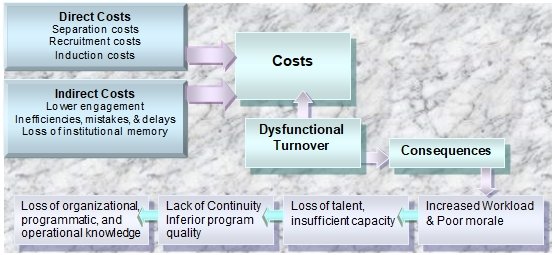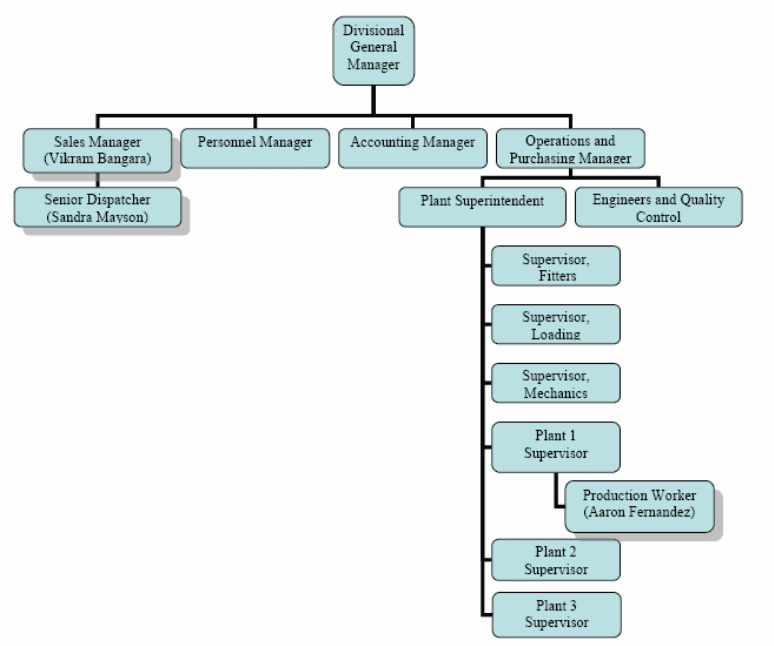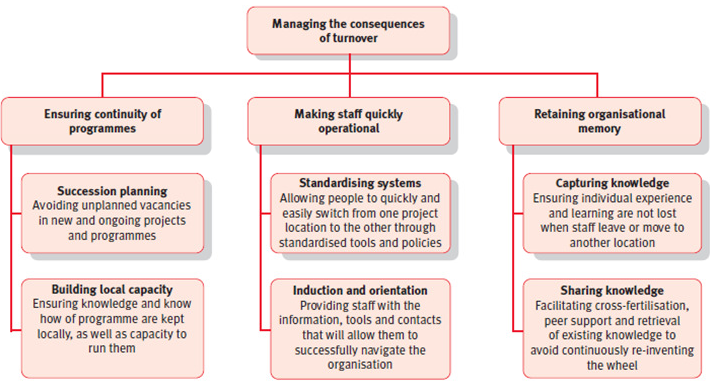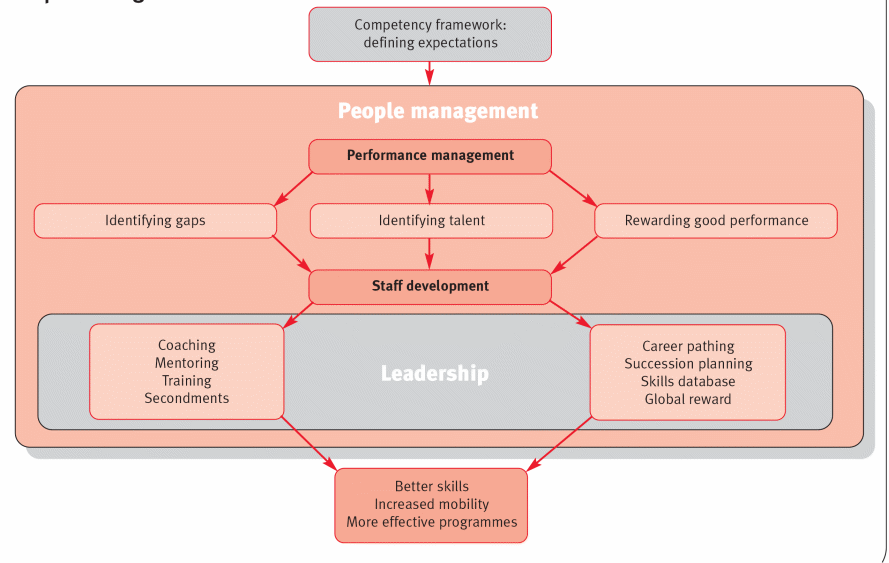Executive Summary
The purpose of this report is to identify the key problems of Constructions Products (subsidiary of Metrivac Company), and to recommend possible solution in order to improve present situation and to increase productivity and profitability.
In order to recommend the company, this report will concentrate on staff turnover rate, leadership crisis, communication, and motivation, reasons of dissatisfaction of the employees, organizational structure, problems of production, sales, and marketing departments.
Problem Identification and Analysis
The Construction Products Company, being a subsidiary of Metrivac Company, is currently undergoing a range of problems related to operations management, motivation, wage patterns, autocratic leadership, recruitment, training, communications, organisational structures, and many more.
According to the case, Aaron Fernandez, as an employee at the company, suffers from some of the problems. One of this problems, for example, include job dissatisfaction, that results from the autocratic style of leadership, appalling workplace environment, pay (which points towards the hygiene factors), company policy and administration, over supervision, interpersonal relations, and the Taylorite approach in operations.
Therefore, Aaron faces tremendous decline in his motivation and feels his job to be extremely monotonous because the production line has designed to produce at a constant rate – where there is no space for job rotation, job enrichment, empowerment, or team working.
Aaron’s job description, as provided in the case, also point towards another big problem that the Construction Products Company is facing – delayed production processes caused by lack of production level employee training, and lack of their motivation as well as poor delegation, poor pay, and a general boredom towards work.
For example, failure of forklift-drivers to substitute steel-shelving swiftly results in breakdowns, and sluggishness of production process (consequently less production); moreover, disinclination of lift-drivers, absence, deprived quality-control in batching, deflection of block-moulds, and poor-compaction of blocks because of machine-failure, together with damages caused by workers throwing foreign-materials over batching-system, and causing cracking of moulds results in one hour delay everyday.
As discussed before, just like Aaron Fernandez, all the other workers in the Construction Products Company suffers from the same problem – poor motivation, job dissatisfaction, awful payment structures and the consequent absenteeism and low quality outcomes resulting from Taylor’s approach to management and leadership that the business adopts.
Aaron expresses himself to be ‘moderately satisfied’ with pay; this is probably due to the way in which his pay is calculated; he gets basic wage-rate and a group-bonus; the group-bonus requires each supervisor to decide on performance-rankings, and therefore bonus-differentials; moreover, Aaron told David Schneider that ‘the worth of a job is determined by the money paid for it’.
Such and comment from an employee indicates that although they are receiving bonuses, the workers are not getting sufficiently motivated due to fact that the bonus payments are liked to performance, which is to some extent equivalent to payment by results, or piece rates; furthermore, forklift drivers are not included in the bonus system.
The employees here do not feel themselves as a part of the business and so do not want to provide something more than they are told to do because of the Taylor-like behaviour they receives from the management. Although there are many theory Y workers who are able to give a lot to the company, the theory X treatment from the upper level subsequently means lack of interests.
In addition, there exists inadequate opportunities for promotion or personal development, pitiable working environment, and the dissatisfaction from doing highly repetitive tasks; moreover new recruits are here one day who depart the next day; this lack of continuity makes it tough to extend downy coordination and more often causes high staff turnover which causes rising recruitment costs of the company.
Apart from high staff turnover and company’s autocratic philosophy, another big problem is in communications – there are the irregular verbal communications of the supervisors with the forklift drivers, floor workers with the managers, or even supervisors with the managers.
Sales dispatcher Sandra Mayson recruited as a salesclerk in 2005, she is now responsible for dispatching orders and supervising three clerks who engaged this department. However, she was satisfied with her job but she was disappointed for facing two problems such as communication problem with the senior manager and excessive workload as she has to handle all minor customer complaints, order delivery issues, and communicate with the staff.
On the other hand, senior executives never appreciates her performance along with complain that she show biased attitudes and delay occurred for her activities though these are not true. In addition, she identified that job pressures, rewards provisions, separate payment method for male and female, seniors like to talk rather than listen, and lack of verbal recognition of her performance by senior executives demoralize her to work in Construction Products.
Vikram Bangara joined in the Construction Products in 1999 as an industrial sales representative, but appointed as a sales manager in 2004 due to his excellent decision-making power and motivational factors.
However, he was initially responsible for sending e-mails, receiving telephone calls, and meeting with customers, communicating with subordinates and superiors; however, he is now in charge for supervising and coordinating all the activities in the sales department, for instance, controlling daily production, and disseminating information returned by representatives, communicating with the potential customers.
According to the view of Vikram, the main problem of the company is leadership approach as Construction Products is controlled by the highly autocratic leaders who enjoyed ultimate power in case of decision making as well as implementation of the strategies.
However, Weihrich & Koontz (2005) argued that Autocratic leadership is the older style of leadership where leaders took the decision and subordinates or team members had to follow the decision and Vliert (2006) stated that autocratic executives act in more self-centered ways, take decisions more unilaterally and it is a less effective and attractive to govern the organizations of developed countries.
In addition, Robbins & Judge (2004) stated that orders must be obeyed approach to the staff demoralize the employees to show their highest efforts and fails to provide quality services to the organizations, which reduce profit margin of the company.
However, the aim of Vikram was to restructure the sales department by developing knowledge and skills of the employees and eliminating any social obstacles to contribute to the department’s success but he identified that senior managers criticize his initiatives, which was also the main cause of his dissatisfaction.
At the same time, the senior managers never appreciate the work of the subordinate is also a great for the development of Construction Products though they implement the suggested strategies of the employees in some extent and provide rewards for their activities, but the company can’t motivate the employees due to their autocratic attitudes.
Statement of Key Problems
Problem One
Poor motivation is a great problem in the firm – an autocratic approach in leadership means that the motivation of the workers is adversely affected. However, apart from autocratic approach, there are some other imperative issues, which cause this insufficiency of motivation.
The hygiene factors, such as low pay, poor working condition, highly repetitive and extremely monotonous tasks, and many other factors create a decline in motivation amongst workers. Lack of motivation also results from an organisational practice that does not ensure equal opportunities, for example, as suggested by Sandra Mayson, women are not paid equally as men.
Poor motivation, in turn, means slower production process, poor quality production, more absenteeism, and high staff turnover, which results in rising operating costs. Increasing staff turnover causes the problems outlined below:

Figure 1: Costs of Increasing Staff Turnover
Source: Self generated from Nierman (2001) and Chavez and Lobo (2010)
Problem two
Autocratic leadership style is one of the key problems as directors of parent company “Metrivac” and other senior executives are not appreciate the performance of the subordinate, take inappropriate decisions without considering feedback of the staff, and force employees to implement the strategies. As a result, the members of the departments of Construction Products cannot work as a team due to lack of communication and leadership problems, which also creates misunderstanding between employees and top-level management.
Problem three
One of the biggest troubles for the company is poor operations management. Inefficiency in operations management results from bad decision making from the managers, lack of training of the low-level workers, and poor job design.
This causes delayed production processes, disappointment to work swiftly, frequent stopped working process, aversion of floor workers, non- attendance, deprived quality, and poor compact of lumps, malfunction of appliances accompanied by damages in moulds, and many other problems in the entire plant.
Problem four
The awful work pressures faced by Sandra Mayson, or the problems in communications faced by all the subordinates of Operations and Purchasing Manager (as argued by production worker Aaron Fernandez) have profound links to a single key problem – a badly designed organizational structure.

Figure 2: Organisational Chart
Source: Construction Products Case
As illustrated in the above organisational chart, there is a tall hierarchal structure under the Operations and Purchasing Manager, which results in a number of problems apart from communicational gaps between the supervisors and the forklift drivers, floor workers and the managers, and even supervisors and the managers.
Additionally, tall hierarchal structure means narrow span of control, resulting in more costly day-to-day running with negative impact over lower level workers. Conversely, there are no subordinates under Sandra Mayson, which is why she faces the great workload.
Generation and Evaluation of a Range of Alternative Solutions
Table 1: Creation and Valuation of Alternative Solutions
Source: Self generated
The figure below shows the ways of managing the consequences of staff retention by enhancing motivation:

Figure 3: Managing Consequences of Turnover
Source: Vale (2010)
The figure below shows the practice of effective strategies that can retain staff:

Figure 4: Practice of effective strategies that retain staffs
Source: Loquercio, et al. (2006)
Recommendations
In order to reduce staff turnover rate, the management of Construction Products should change entire recruitment and selection system to appoint most competent person for the post who can take workload, behave gently, dynamic, educated, and have previous experience in particular job as the company employed 150 unskilled production employees.
As Construction Products discriminate male and female in terms of payment policy, it should follow the employment law of Australia and ethical code of conducts in order to develop organisational culture, and ensure equal opportunity for all irrespective of race, ethnic minority and so on.
However, the leader should consider democratic leadership approach instead of Autocratic approach and the management should train the employees to work as a team, which will help Construction Products company to satisfy the employees and reduce internal problems.
Implementation
Following figure shows recommended strategic leadership and management process for Construction Products as it should have anticipation, envision and flexibility to implement projects –

Figure 5: Strategic L&M process for Construction Products
Source: Self generated from Hitt, Ireland, Hoskisson (2001, p.488)
As Construction Products has unskilled along with mental employees, it should have experienced R&D team, training department skilled leader who have motivational power and good communicating skills to bring success for the company by implementing strategy.
However, directors of Metrivac Company should communicate with the employees each department of Construction Products, regularly meet with the employees of outlets and periodically visit the production department to know the problems of the staff, and their opinion to take major decisions, as different employees have dissatisfied for different reasons.
Reference List
Chavez, J. L. & Lobo, V. (2010) ITR’s Six Sigma Approach to Reducing Its Employee Turnover Rate. Web.
Griffin, R. W. (2006) Management. (8th ed.). New York: Houghton Mifflin Company.
Hitt, M. A., Ireland, R. D., & Hoskisson, R. E. (2001) Strategic Management. (4th ed.). South-Western Thomson Learning.
Johnson, G. Seholes, K. & Whittington, R. (2008) Exploring Corporate Strategy: Text & Cases. 8th ed. London: FT Prentrice Hall.
Kotler, P. (2003). Marketing Insights from A to Z:80 concepts every manager needs to know. (10th ed.). New York: John Wiley & Sons Inc.
Loquercio, D. (2006) Turnover and retention: General summary. Web.
Nierman, L. (2001) What Is the True Impact Of Employee Turnover?. Web.
Robbins, P. S. and Judge, A. T. (2004). Organisational Behavior. (12th ed.). London: Prentice Hall.
Vale, I. (2010) Addressing Staff Retention & Improving staff engagement. Web.
Vliert, E. V. D. (2006) Autocratic Leadership Around The Globe Do Climate And Wealth Drive Leadership Culture? Journal of Cross-Cultural Psychology, 37(1): 42-59. Web.
Weihrich, H. & Koontz H. (2005). Management a Global Perspective. New Delhi: Tata McGraw-Hill.